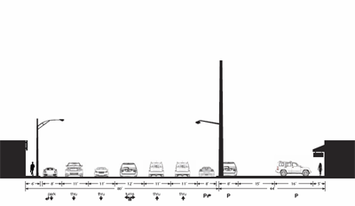Jack Nicholson dies off screen...
... while the camera focuses on the little Spanish plaza in the famous final scene of Antonioni's The Passenger (1975).
2010-01-25
2010-01-22
*** Sidewalk Weekend *** #35
 Sidewalk Rating: Certain Death!
Sidewalk Rating: Certain Death!I slipped and fell on the sidewalk last night. It had an ultra-thin coating of ultra-slick ice, made all the more trecharous by the fact that the decorative (beautiful to look at) sidewalks in Highland Park Saint Paul (along Ford Parkway and Cleveland Avenue) are actually quite without frictive qualities (slippery to walk on). This mirrors another observation I made a little while ago about how the paint of crosswalks (a "safety feature") are often more slippery than the asphalt they surface.

Be careful out there, Twin Cities. Neither bruise your elbow, nor break the fragile contents of your bag. Do not sprain your dignity!
Update: The same brick pavers line the sidewalks of downtown Saint Paul where I just saw a good play. Warning, These red bricks are slipperier than a Wall Street lobbyist!
*** ***
 And I thought Mid-Century Modernism was only good for furniture. Turns out its good for walkable strip malls...
And I thought Mid-Century Modernism was only good for furniture. Turns out its good for walkable strip malls...
*** ***
Speaking of which, watch as this chair moves through Manhattan, tempting passers by.
See as they "curb mine" furniture, carefully lingering by the chair, looking around the sidewalk, then nonchalantly uproot: the underarmchair.
*** ***

But I'm still not ready to embrace "mid-70's kitchmodern" or whatever the LV Strip was called back then.
*** ***
Both updating Jane Jacobs’s vision of urban life and criticizing its failure to confront the power of investors and developers, the book enters the still-raging debate between those who want to build big, in Robert Moses’s style, and those who want to preserve the “authentic” city of neighborhoods and local identities.
Jane Jacobs legacy is under attack from Sharon Zukin, of all people? (Seems unfounded. She's often mistaken for a nostalgiaholic.)
*** ***
A good point:

*** ***
Operatic Twin Cities:
*** ***
Let us mourn his passing:

*** ***
If only I could ride the A Train with Donald Byrd.

2010-01-11
Exurban sprawl speculation crashing local banks

[A depressing 186-acre parcel of land in Ramsey was once a planned site for 600 houses. Img. Glen Stubbe, Strib]
This Strib article is why you should always glance at the Business section before you line your birdcage. It's an article on the commercial real estate bubble, and how highly vulnerable smaller, local banks are to the impending foreclosure and over-building of speculative commercial property.
I remember reading about this a while ago, when my small, local bank was listed as being overly leveraged with bad mortgage debt. Well, the commercial real estate bubble ends up hitting these smaller banks far more than larger ones, whih turns exurban farm fields and second-ring stripmalls into our own miniature Dubai. Here are the important quotes from the piece:
From unfinished housing projects in the far northern suburbs to emptying office parks in Edina, developers are walking away from their debts -- forcing banks to take large write-downs. Last week, for instance, a commercial broker began marketing 186 acres of raw land in Ramsey, intended for 600 houses, that was taken over by a Wisconsin bank. And later this month, a 200,000-square-foot portion of the Twin Cities' first suburban office park -- Pentagon Park in Edina -- will be sold at a foreclosure auction after its owners defaulted this summer on an $18.5 million mortgage.
[...]
Yet, bankers say they have been hit particularly hard by rising vacancy rates in strip centers. The retail vacancy rate for the metro area hit 10.1 percent last year -- the highest level since NorthMarq, a commercial real estate company based in Bloomington, began tracking the data more than a decade ago.
This has two noticeable effects. The first is that is shows how the financial speculation and banking fiasco are tied to sprawl and speculation. Almost our 21st century economic growth was based on real estate speculation, and this influx of made-up cash gave lots of construction workers jobs, lots of people houses they couldn't afford, and (for a short time) high profits for banks and financial companies. Well, the end of this ponzi scheme means that a lot of parcels of land, and a lot of retail and commercial properties aren't worth much anymore.
It also reminds me of how overbuilt the US retail sector is, in general. In her book Big Box Swindle, ISLR author Stacy Mitchell describes how we have way more retail real estate than we would ever possibly need. Our cities and suburbs are way past saturated with big box stores, malls, and everything else under the sun. And for a long time, due to a lucratice regulatory climate (tax breaks for depreciation, up-front tax money from cities), these have been rock solid investments.
Well, things may be changing now, and the suburban landscape may soon look a lot like the North Minneapolis housing situation. Abandoned stores, abandoned malls, abandoned Denny Hecker dealerships. If you're an urban planner, what do you do with an empty Circuit City store?

Bonus:
A recent quote from Kunster's latest screed talking about the immanent downfall of over-leveraged local banks:
It reminds me They may go down anyway, because the catastrophe of commercial real estate is following right on the heels of the fiasco in residential real estate. The vast oversupply of malls, strip malls, office parks, and other furnishings of the expiring "consumer" economy is about to become the biggest liability that any economy in world history has ever seen. Who will even want to buy these absurd properties cheaply, when they will never find any retail tenants for the badly-built structures, nor be able to keep up with the maintenance (think: leaking flat roofs), or retrofit them for anything? In a really sane world, a lot of these buildings would go straight to demolition-and-salvage -- except that it costs money to do that, and who exactly right now will make a market for used cinder blocks and aluminum window sashes? I expect these places to become squats for the desperate homeless.
Subscribe to:
Comments (Atom)